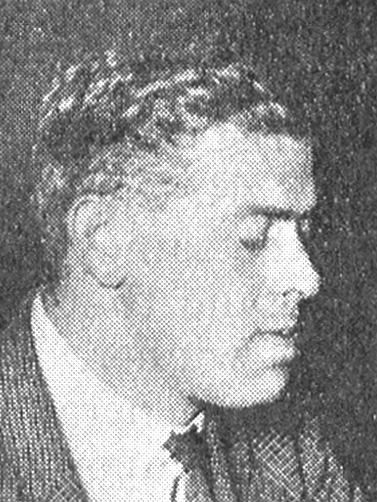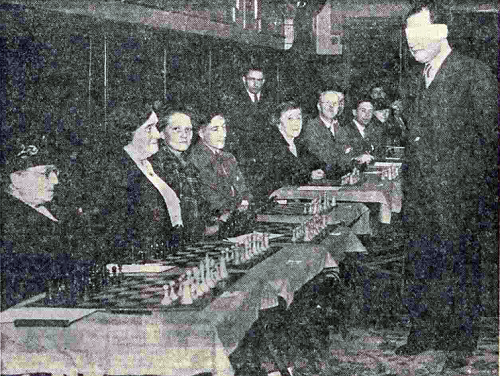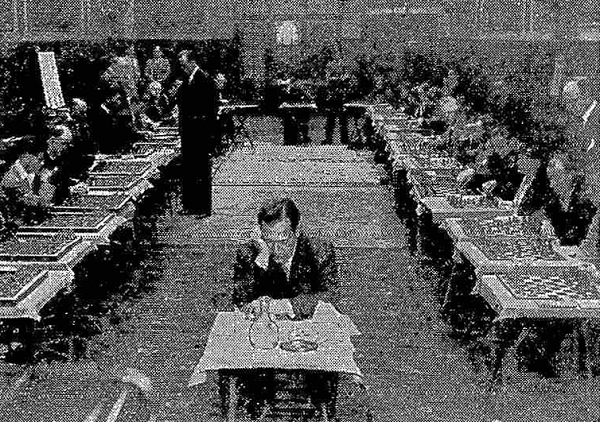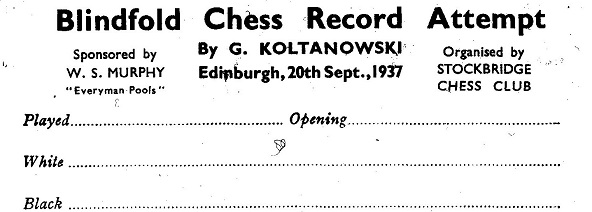 |
|
|
Koltanowski's World Blindfold Record
Georges Koltanowski of Belgium created a new world record for 'blindfold' play in the Albyn Rooms, Edinburgh, on Monday, 20 September 1937. He played against 34 opponents and scored 24 wins and 10 draws. The previous record was 32 boards, set by Alexander Alekhine in Chicago in 1933.
Play began at 10:30 a.m. and went on for 13½ hours, until midnight. There were two breaks for meals, the total time being allowed for these being no more than an hour and a half.
W. Allan Miss JV Kessen G. Baker R. Laing Mrs J. Brockett Miss JR Lamb AG Burnett Mrs A. MacFarlane J. Cairns Miss B. Mason Miss M. Crum RJ McRobbie Miss MacD Clark Mrs L. Prenter RD Ewart Mrs MM Ritchie W. Geddes AJ Smith HD Gemmell G. Stott Miss MD Gilchrist FBT Salvesen F. Gould Miss F. Tweedie WW Graham M. Todd GP Granger Miss M. Tweedie A. Henderson W. Wills Miss E. Henderson J. Wilkes DS Hood WL Thomson NOTE:
Koltanowski has Wells at board 32.
Granger (14) is the correct spelling.
Glasgow Herald, 25 September 1937 has Grainger and Willis.
Crosstable: The Scotsman, 21 September 1937, p.14.
From left-right: Allan, Baker, Wilkes
From the Glasgow Herald of 21 September 1937
The Belgian master sat at a distance from his opponents, with his back to them, and by means of tellers exchanged moves by word of mouth with each in rotation. To enable him to separate the games Koltanowski first of all began with having the moves called in the Continental notation on the first 15 boards, and in the English notation on boards 16 to 34.He then varied the openings from board to board in groupings of five alternate Queen's Pawn and King's Pawn openings. By this means he quickly had every games with a distinctive character of its own, and therefore easier to record in his mind.
Having survived that stage Koltanowski moved quickly, and by the middle of the afternoon had scored four wins. However, at this point he appeared once or twice to have difficulty with his boards, but after some hard thinking (evidently going over the moves played) he recalled the positions correctly and resumed his quick play. At no other stage of the display did he show the slightest hesitation.
At the tea interval after more than five hours' play he had finished ten games which gave him seven wins and three draws. Half-way stage in the results was reached at 8 p.m. and his score was then 12 wins and 5 draws.
The Courier and Advertiser, 21 September 1937, page 7
A posed photograph for publicity purposes. Unfortunately, no details were given about the players, which might have helped confirm the board order.
Glasgow Herald of 25 September 1937
At the close of play Koltanowski appeared not the least tired, and at 11 he wouldn't listen to a suggestion that the nine surviving games should be adjudicated. Half an hour later his opponents were reduced to five, and a defeat for Miss Crum, a draw for R. Laing, and a defeat for W.L. Thomson brough the performance to midnight, and only W. Geddes and Miss Gilchrist left. Geddes had a fairly level position, but Miss Gilchrist was losing, and the play was concluded by the former accepting a draw, and Miss Gilchrist admitting defeat.Koltanowski sat at a small table some little distance from the players, with his back to them, armed with a supply of milk, cigarettes, Eau de Cologne, and smelling-salts. All through the display he kept the company in good humour with asides and stage whispers, sometimes at his own expense, but mostly at the expense of his opponents. For a short period in the afternoon he seemed to have difficulty in recalling some of the positions, but apart from that he made the performance appear as if it were quite easy. The final score is evidence of the class of chess he played, and that he made no bad moves or oversights of any kind.
The Scotsman, 21 September 1937, page 14.
________
Tellers: R.D. Dykes, R.F.D. Hayman
Controllers: F.R. Gould, R.R. Stevenson and I. HamiltonThe event was organised by the Stockbridge Chess Club of Edinburgh
and sponsored by W.S. Murphy, the promoter of Everyman's Pools.
The Musselburgh News of 11 June 1937 reported that Mr Murphy had offered £500 for the event, but would pay Koltanowski £1,000 if the world record was broken.
Additional notes and games
Koltanowski, in his own writings, has contributed to confusion about the results of this display. Apart from giving varying reports of how he mentally segregated the boards, he also provided a game score that showed he won against Geddes (board 9), whereas all other reports give the game as draw. The Glasgow Herald report above refers to Geddes and Miss Gilchrist being the last two games to finish; Miss Gilchrist resigned and Geddes accepted a draw.In Blindfold Chess, by Eliot Hearst and John Knott, the authors point out that in three of his books Koltanowski showed board 9 as a draw. However, in George Koltanowski: Blindfold Chess Genius (1990) he provided a score showing he won in 28 moves. Hearst and Knott take into account the possibility that Koltanowski confused his scores, but they point out that there is no other game in the 1990 book that could be the "real" draw. It appears that Koltanowski provided the wrong score in his 1990 book and that the Geddes game score is therefore "missing."
Koltanowski had, by his own accounts, refrained from playing chess for six months in preparation for this exhibition (British Chess Magazine 1937, p. 543). In the same BCM article Koltanowski elaborated on his system for memorising the boards:
'I divided my boards up into fives; thus the first five boards 1. P-K4, the second five 1. P-Q4, etc. Then came a second division. For example, on Board 1, if my opponent played a Sicilian, I played as second move P-QKt4. This I would do every first Sicilian in every set of five. On Board 5, again a Sicilian, I played the normal variation. It was very doubful that there would be more than two Sicilians in every five King's Pawn openings. And I had the same idea worked out for every opening. This sounds easy; but the main difficulty lies in the fact that I had to remember which board had played the first Sicilian or Caro-Kann in the set.'
The players were seated not acording to relative playing strength, but alphabetically (yes, I have noted that boards 6 and 7 could have changed places, that M. Todd placed himself comfortably between the Misses Tweedie, and that Thomson could have been at board 29!).
Many women were very active in chess circles in Scotland at this time (there was both an Edinburgh Ladies' CC and a Glasgow Ladies' CC), so it is not surprising that there were thirteen members of the fairer sex playing. Mrs Brockett (Board 3), Miss Crum (6), Miss Gilchrist (11), and Mrs Ritchie (25) had all won the Scottish Ladies' championship. Miss Gilchrist had also won the British Ladies' title in 1929 and 1934.
The opposition was selected predominantly from the Stockbridge Chess Club, who organised the event, and the Edinburgh Ladies' CC. Miss Betty Mason (board 22) and Miss Elizabeth Henderson (board 16) were previous winners of the Girls' Tournament.
In general, though, the opposition was weak and almost 50% of the games ended in 16 moves or less. Some were quick draws, which Koltanowski was happy to give as it reduced the pressure on himself, but the number of quick losses detracted from the importance of the display.
GAMES
Angus Burnett was Scottish Boys' champion in 1931, 1933 (shared with A.A. Thomson), and 1934 (after winning the deciding game with A.A. Thomson). He was successful in club and league chess in Edinburgh, distinguished himself in several Scottish Championships and played in the 1951 Scotland-England match.
Koltanowski - A.G. Burnett [C55]
Edinburgh, 1937 (Board 4)
[Notes by Koltanowski]
1.e4 e5 2.Nf3 Nc6 3.Bc4 Bc5 4.0-0 Nf6 5.d4 exd4 6.e5 d5 7.exf6 dxc4 8.Re1+ Be6 9.Ng5 Qd5 10.Nc3 Qf5 11.Nce4 Bf8 12.Nxf7 Kxf7 13.Ng5+ Kg6 14.Nxe6 [The theoretical continuation here is 14.Rxe6 but I wanted to bring my opponent into the open.] 14...gxf6 15.g4 Qa5 16.Bd2 Qb6 [16...Bb4 was better.] 17.Qf3 Be7 18.Qf5+ This and the following five moves were announced together. I mention this, not because it is unusual for a chess master, but because of the occasion. 18...Kf7 19.Qh5+ Kg8 20.Qh6 Bf8 21.Qxf6 Ne7 22.Bh6 Bxh6 23.Qxh6 1-0 Black loses both of his Rooks.
Source: Adventures of a Chess Master, by George Koltanowski, David McKay Co., New York, 1955. The game (without notes) was also part of the report in the Glasgow Herald of 21 September 1937.Koltanowski - Miss M.D. Gilchrist [B20]
Edinburgh, 1937 (Board 11)
[AMcG]1.e4 c5 2.b4 cxb4 3.a3 d5 4.e5 Nc6 5.d4 e6 6.axb4 Nxb4 7.c3 Nc6 8.Bd3 Nge7 9.Ne2 Ng6 10.0-0 Be7 11.f4 0-0 12.Ng3 Bd7 13.f5 exf5 14.Nxf5 Be6 15.Qh5 Re8 16.Rf3 f6 17.Rh3 Nf8 18.Nxe7+ Nxe7 19.Bxh7+ Nxh7 20.Qxh7+ Kf7 [20...Kf8 is even weaker because of 21.exf6] 21.exf6 [More effective would have been 21.Rh6 threatening 22. Rxf6+] 21...Bxh3 22.Qxg7+ Ke6 23.fxe7 Rxe7 24.Qh6+ Kf7 25.Qh5+ [25.Qh7+ was better. After the text move, allowing the King to retreat to g8, Black is able to mobilise her remaining heavy pieces and make use of the e- and f-files ] 25...Kg8 26.Bg5 Re1+ 27.Kf2 Qf8+ 28.Kxe1 Re8+ 29.Kd1 Qf1+ 30.Kc2 Re2+ [Miss Gilchrist could have caused great trouble to White by 30...Bf5+ for example, 31.Kb3 Qb5+ 32.Ka2 Re6] 31.Nd2 Bf5+ [31...Qxa1 32.Qg6+ Kf8 33.Bh6+ etc.] 32.Kb2 Qxg2 33.Kb3 Rxd2 34.Bxd2 Keeping it simple. After all, he had been at this for 13½ hours. 1-0
Source: Glasgow Herald of Saturday, October 2, 1937.
Sources:
For the board order:
Adventures of a Chess Master, by George Koltanowski, David McKay Co., New York, 1955, p 35.
The Scotsman, 21 September 1937, page 14.Others:
Blindfold Chess, by Eliot Hearst and John Knott (McFarland, 2009)Compiled by Alan McGowan
updated 29/11/2023



